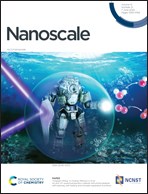Bistable behavior of the nitrogen impurity in SiC nanoclusters
Abstract
Nitrogen doped SiC nanoclusters of various shapes and polytype structures were modeled in the framework of density functional theory using the PBE0 hybrid functional. While in the bulk crystal NC impurity may be introduced in a large concentration and shows features of the conventional shallow effective-mass donor, in the nanocluster this defect can exist in two forms with sharply different electronic structures. The first one resembles the shallow donor confined in the nanocluster with a small and nearly isotropic lattice relaxation, and spin density spread over distant shells. The second form resembles a small bound polaron structure with a large and anisotropic lattice relaxation, which leads to a strong localization of the spin density on one of the nearest silicon atoms. Relative energies of these two states depend on the location of nitrogen in the lattice as well as on the shape and polytype structure of the nanocluster. The calculations show that the position of the impurity in the vicinity of the hexagonal double layers and cluster surface facilitates the formation of small-bound-polaron-like states. As follows from the calculations, the two impurity states can be experimentally distinguished by the values of the hyperfine and quadrupole coupling parameters that can be measured in magnetic resonance experiments. They are also characterized by rather different electronic absorption spectra. We have demonstrated that for negatively charged SiC nanoclusters the polaron-like impurity states can be formed even if they do not exist in neutral clusters. This provides a reason to believe that the nitrogen impurity occupying particular sites in SiC nanoclusters is an analog of the DX centers in the bulk crystal. In addition, the formation of the polaron-like states depends on the method of the surface passivation. In particular, the substitution of the Si–H surface bond with the Si–NH3 one facilitates a bistable behavior of the NC impurity located in the central part of the nanocluster. We have also shown that the effect of the self-purification manifests itself in different ways depending on the nanocluster shape and polytype structure.



 Please wait while we load your content...
Please wait while we load your content...